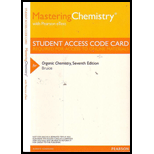
Concept explainers
Interpretation:
The mechanism for the given reaction should be determined.
Concept introduction:
Addition Reaction: It is defined as
The product of electrophilic addition reaction obtained by addition of electrophile to
Electrophile: Electrophiles are electron deficient compounds which accepts electrons from nucleophiles that results in bond formation.
Regioselective reaction: They are reactions which contain more than one product which are actually molecules with same molecular formula but different in the way they are connected and among those products only one product is major.
Acid Catalyzed Hydration Reaction: The reaction involves breaking of phi bonds between carbon-carbon multiple bonds and addition of alcohol to more substituted position of carbon in the molecule.
First step is the acid donates proton to the
Then, the water is added to the given alkene through acid catalyzed reaction where the water gets added to the carbo cation finally, the removal of one proton from oxonium ion (oxygen with one positive charge) using water results in the formation of product.
Want to see the full answer?
Check out a sample textbook solution
Chapter 6 Solutions
Organic Chemistry - Access
- Four of the seven steps in the mechanism for this process are shown in the conversion of acetal A to hemiacetal E. a.) Add curved arrows for each step b.) Draw another resonance structure for C.c.) Identify the nucleophile and electrophile in Step [3].d.) Which steps are Brønsted–Lowry acid–base reactions?arrow_forwardPredict the products of reaction of pent-1-yne with the following reagents.(a) 1 equivalent of HCl (b) 2 equivalents of HCl (c) excess H2, Ni(d) H2, Pd>BaSO4, quinolinearrow_forwarda) Give the appropriate base for the above reaction and draw the resonance structures of the enolate ions derived from compound A. Then write the mechanism for the formation of the Dieckmann cyclized product B. b) If compound B above is reacted with NaBH 4 , draw the structure of the reduced product. Give a reason for your choice of product. c) Being a β-ketoester, B could undergo a 3-step synthesis involving alkylation, hydrolysis and decarboxylation reactions to yield the cyclopentanone, C. Write the outline synthesis for each step which include the appropriate regents and correct intermediate.arrow_forward
- Propose a mechanism for the reaction of aniline with ethyl acetate to give acetanilide.What is the leaving group in your proposed mechanism? Would this be a suitableleaving group for an SN2 reaction?arrow_forwardodine monochloride, ICI, is a reagent whose reactivity mirrors that of other dihalogens (X₂) with nucleophilic πt bonds. Using curved arrows to show the flow of electrons, draw a plausible mechanism for the following transformation. Make sure that your mechanism accounts for the correct stereoselectivity.arrow_forwardPredict the product from reaction of 1-hexyne with the following reagents: a)NaNH2 in NH3, then CH3Br b) BH3 in THF, then H2O2OH-arrow_forward
- Scheme 1: Reagents: (a) acetic anhydride, sulfamic acid, 60°C,30min,91%; (b) Et3SiH,I2,0-5°C,30min,82%. 1) Draw the FULL, ARROW-PUSHING MECHANISM 2) Provide a verbalization of the mechanism for your reaction mechanism 3) What is happening at each step? What atom is nucleophilic? Which atom is electrophilic? Which bonds are made? Which bonds are broken? 4) Imagine you are trying to describe the reaction mechanism and I can't see your display - how would you describe the mechanism in a way that I know, that you know, what you are talking about.arrow_forwardPropose a mechanism for the reaction of BH3 with water. The products of the first reaction are H2 gas and BH2OH. What are the products after reaction with two additional water molecules?arrow_forward
